three.js之几何体-自定义二维图形ShapeGeometry(vue中使用three.js23)
ShapeGeometry几何体介绍和使用
1.ShapeGeometry几何体介绍
ShapeGeometry可以用来创建自定义的二维图形,实际上ShapeGeometry创建图形必须要用到基类Shape,我们先来看看它的原型链:
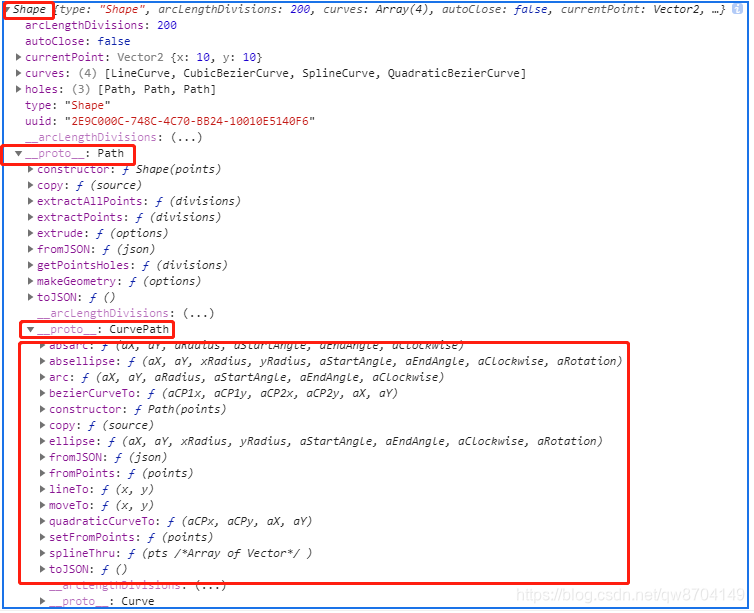
没错,Shape类继承自Path类,Path类由继承自CurvePath类,我们用来画图的方法实际都是从CurvePath继承来的,现在我们介绍一下这些方法:
| 函数名 | 描述 |
|---|---|
| moveTo(x,y) | 将函数绘图点移动到指定的坐标 |
| lineTo(x,y) | 从moveTo指定的位置开始画一条线到(x,y)指定的坐标 |
| quadricCurveTo(aCPx,aCPy,x,y)(二次曲线) | 你可以用两种方法来定义曲线,用quadricCurveTo或bezierCurveTo函数,这两种方法的不同是一个通过一个点控制曲线的曲率,一个用两个点,下图是二者的示意图 对于二次曲线,需要额外指定一个点(使用aCPx和aCPy参数),还需要指定端点(x和y)。对于三次曲线需要用bezierCurveTo函数绘制,需要多指定两个点才能绘制, 对于二次曲线,需要额外指定一个点(使用aCPx和aCPy参数),还需要指定端点(x和y)。对于三次曲线需要用bezierCurveTo函数绘制,需要多指定两个点才能绘制, 起点都是路径的当前点 |
| bezierCurveTo(aCPx1,aCPy1,aCPx2,aCPy2,x,y) | 根据提供的参数画一条曲线,相关说明参考前一行内容,该曲线绘制需要四个点:起点是路径的当前点,连个点用来控制曲率,最后一个点是端点 |
| splineThru(pts) | 该函数沿着提供的坐标集合绘制一条光滑的曲线,这个参数是一个THREE.Vector2对象数组,起点是路径的当前位置 |
| arc(ax,ay,aRadius,aStartAngle,aEndAngle,aClockwise) | 画圆(或者一段弧),起始于路径的当前位置,ax和ay用来指定圆心与当前位置的偏移量,aRadius设置圆的大小,aStartAngle和aEndAngle用来定义弧的长度,布尔属性aClockwise决定这段弧是顺时针还是逆时针 |
| absArc(ax,ay,aRadius,aStartAngle,aEndAngle,aClockwise) | 参考arc的描述,该方法绘制的弧是绝对位置,而不是相对位置 |
| ellipse(ax,ay,xRadius,yRadius,aStartAngle,aEndAngle,aClockwise) | 画椭圆参考arc的描述,可以通过xRadius指定x轴半径,通过yRadius指定y轴半径 |
| absEllipse(ax,ay,xRadius,yRadius,aStartAngle,aEndAngle,aClockwise) | 参考ellipse的描述,该方法绘制的椭圆是绝对位置,而不是相对位置 |
继续往下看:
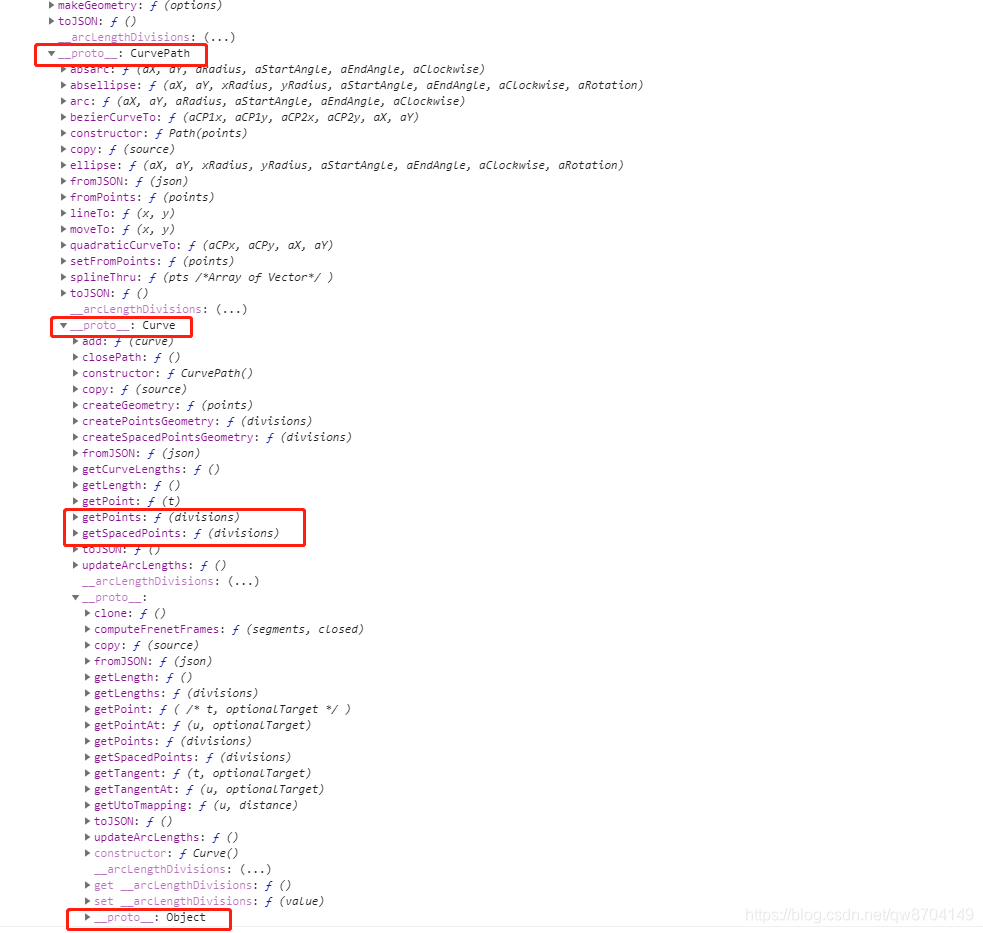
CurvePath继承自Curve类,Curve类又继承自Object类,果然一切皆对象啊,随后我们要介绍一下继承自Curve类的getPoints和getSpacedPoints方法
| 函数名 | 描述 |
|---|---|
| getPoints(n) | 从路径的每一个部分返回n个点 |
| getSpacedPoints(n) | 从整个路径返回n个点 |
2.demo说明
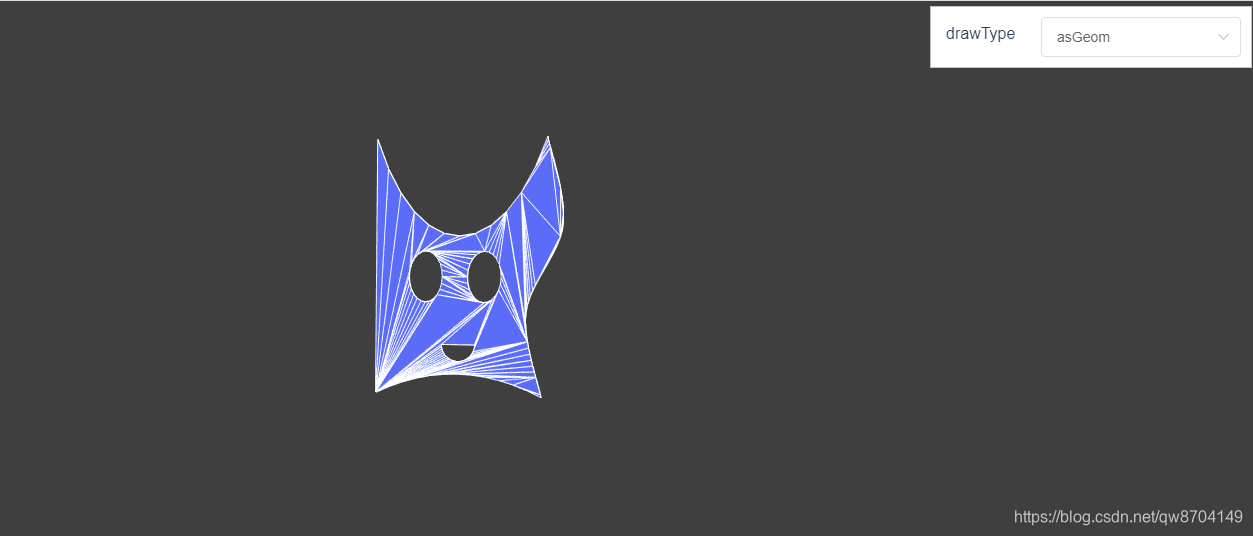
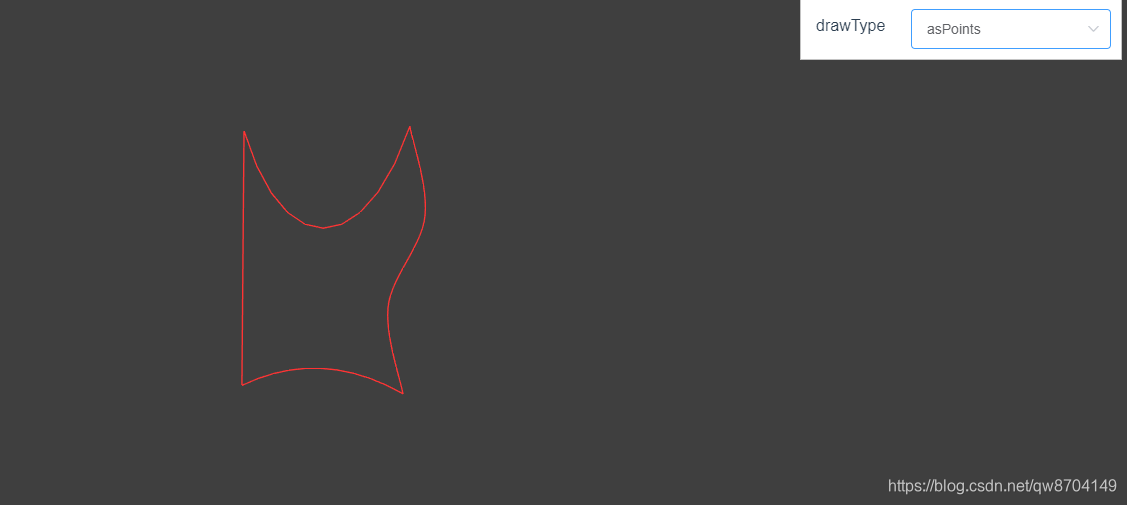
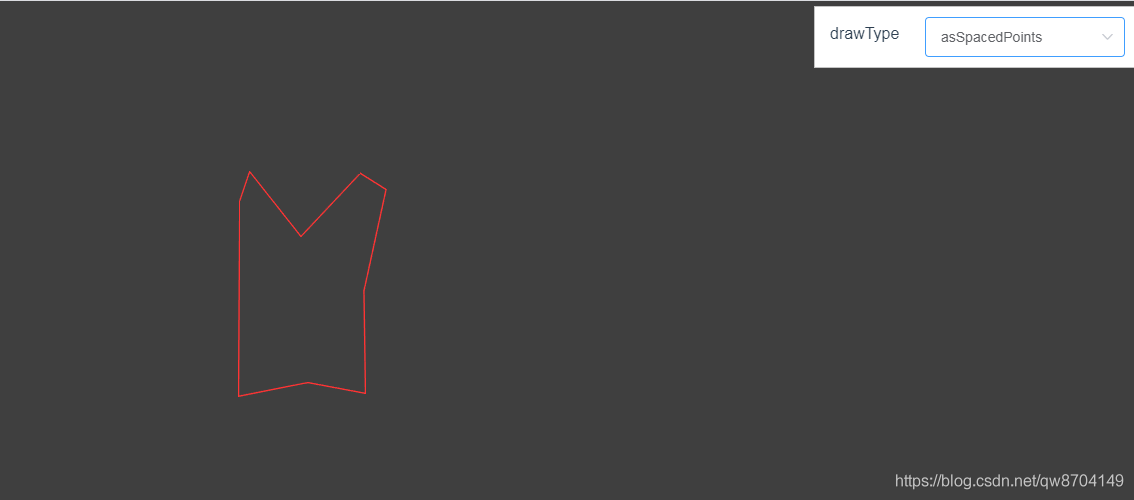
该示例可以通过drawType属性切换不同的绘图方式,绘出上面三种不同的图形,
3.demo代码
<template>
<div>
<div id="container"></div>
<div class="controls-box">
<section>
<el-row>
<el-col :span="8" class="label-col"><label>drawType</label></el-col>
<el-col :span="16">
<el-select v-model="drawType" placeholder="请选择">
<el-option v-for="item in options" :key="item.value" :label="item.label" :value="item.value">
</el-option>
</el-select>
</el-col>
</el-row>
</section>
</div>
</div>
</template>
<script>
import * as THREE from 'three'
import { OrbitControls } from 'three/examples/jsm/controls/OrbitControls.js'
import { SceneUtils } from 'three/examples/jsm/utils/SceneUtils.js'
export default {
data() {
return {
options: [
{
value: 'asGeom',
label: 'asGeom'
},
{
value: 'asPoints',
label: 'asPoints'
},
{
value: 'asSpacedPoints',
label: 'asSpacedPoints'
}
],
drawType: 'asGeom',
activeShapeMesh: null,
camera: null,
scene: null,
renderer: null,
controls: null
}
},
mounted() {
this.init()
},
methods: {
formatTooltip(val) {
return val
},
// 初始化
init() {
this.createScene() // 创建场景
this.createMesh() // 创建网格模型
this.createLight() // 创建光源
this.createCamera() // 创建相机
this.createRender() // 创建渲染器
this.createControls() // 创建控件对象
this.render() // 渲染
console.log(this.drawShape())
},
// 创建场景
createScene() {
this.scene = new THREE.Scene()
},
drawShape() {
// 创建基础形状
const shape = new THREE.Shape()
// 设置起始点
shape.moveTo(10, 10)
// 画线到新坐标
shape.lineTo(10, 40)
// 贝塞尔曲线
shape.bezierCurveTo(15, 25, 25, 25, 30, 40)
// 样条曲线
shape.splineThru([
new THREE.Vector2(32, 30),
new THREE.Vector2(28, 20),
new THREE.Vector2(30, 10)
])
// 底部二次曲线
shape.quadraticCurveTo(20, 15, 10, 10)
// 左眼
const hole1 = new THREE.Path()
hole1.absellipse(16, 24, 2, 3, 0, Math.PI * 2, true)
shape.holes.push(hole1)
// 右眼
const hole2 = new THREE.Path()
hole2.absellipse(23, 24, 2, 3, 0, Math.PI * 2, true)
shape.holes.push(hole2)
// 嘴巴
const hole3 = new THREE.Path()
hole3.absarc(20, 16, 2, 0, Math.PI, true)
shape.holes.push(hole3)
return shape
},
// 创建网格模型
createMesh() {
// 创建二维几何体
const geom = new THREE.ShapeGeometry(this.drawShape())
// 创建材质
const meshMaterial = new THREE.MeshNormalMaterial({
side: THREE.DoubleSide
})
const wireFrameMat = new THREE.MeshBasicMaterial({ wireframe: true })
// 平面添加组合材质
this.activeShapeMesh = SceneUtils.createMultiMaterialObject(geom, [
meshMaterial,
wireFrameMat
])
// 平面对象添加到场景中
this.scene.add(this.activeShapeMesh)
},
// 创建光源
createLight() {
// 环境光
const ambientLight = new THREE.AmbientLight(0xffffff, 0.1) // 创建环境光
this.scene.add(ambientLight) // 将环境光添加到场景
const spotLight = new THREE.SpotLight(0xffffff) // 创建聚光灯
spotLight.position.set(-40, 60, -10)
spotLight.castShadow = true
this.scene.add(spotLight)
},
// 创建相机
createCamera() {
const element = document.getElementById('container')
const width = element.clientWidth // 窗口宽度
const height = element.clientHeight // 窗口高度
const k = width / height // 窗口宽高比
// PerspectiveCamera( fov, aspect, near, far )
this.camera = new THREE.PerspectiveCamera(35, k, 0.1, 1000)
this.camera.position.set(-30, 30, 180) // 设置相机位置
this.camera.lookAt(new THREE.Vector3(10, 0, 0)) // 设置相机方向
this.scene.add(this.camera)
},
// 创建渲染器
createRender() {
const element = document.getElementById('container')
this.renderer = new THREE.WebGLRenderer({ antialias: true, alpha: true })
this.renderer.setSize(element.clientWidth, element.clientHeight) // 设置渲染区域尺寸
this.renderer.shadowMap.enabled = true // 显示阴影
this.renderer.shadowMap.type = THREE.PCFSoftShadowMap
this.renderer.setClearColor(0x3f3f3f, 1) // 设置背景颜色
element.appendChild(this.renderer.domElement)
},
// 更新属性
updateFun() {
const tempRotationY = this.activeShapeMesh.rotation.y
this.scene.remove(this.activeShapeMesh)
if (this.drawType === 'asGeom') {
this.createMesh()
} else {
let points = []
// 创建用来画线的几何体的三种方式:
// 1.创建Geometry对象,把每个点设置到Geometry对象的vertices属性中-shapeGeometry0
// 2.创建BufferGeometry对象,通过setFromPoints()设置点-shapeGeometry1
// 3.创建Geometry对象,通过setFromPoints()设置点-shapeGeometry2
// const shapeGeometry0 = new THREE.Geometry()
if (this.drawType === 'asPoints') {
points = this.drawShape().getPoints(10) // 从shape路径的每一个部分返回10个点
} else if (this.drawType === 'asSpacedPoints') {
points = this.drawShape().getSpacedPoints(10) // 从整个shape路径返回10个点
}
/* points.forEach(pointItem => {
shapeGeometry0.vertices.push(
new THREE.Vector3(pointItem.x, pointItem.y, 0)
)
}) */
// const shapeGeometry1 = new THREE.BufferGeometry().setFromPoints(points)
const shapeGeometry2 = new THREE.Geometry().setFromPoints(points)
// new THREE.Line 同new THREE.Mesh一样创建的是网格对象 需要两个参数:geometry几何对象和material材质对象
this.activeShapeMesh = new THREE.Line(
// shapeGeometry0,
// shapeGeometry1,
shapeGeometry2,
new THREE.LineBasicMaterial({
color: 0xff3333,
linewidth: 2
})
)
this.scene.add(this.activeShapeMesh)
}
this.activeShapeMesh.rotation.y += tempRotationY + 0.01
},
render() {
this.updateFun()
this.renderer.render(this.scene, this.camera)
requestAnimationFrame(this.render)
},
// 创建控件对象
createControls() {
this.controls = new OrbitControls(this.camera, this.renderer.domElement)
}
}
}
</script>
<style>
#container {
position: absolute;
width: 100%;
height: 100%;
}
.controls-box {
position: absolute;
right: 5px;
top: 5px;
width: 300px;
padding: 10px;
background-color: #fff;
border: 1px solid #c3c3c3;
}
.label-col {
padding: 8px 5px;
}
</style>